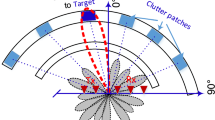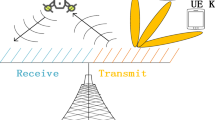Abstract
We study hybrid beamforming design for millimeter wave dual-function radar-communication system, which simultaneously performs downlink communication and target detection. With two typical analog beamformer structures, we consider the hybrid beamforming design to minimize a weighted summation of radar and communication performance. Leveraging Riemannian optimization theory, a manifold alternating direction method of multipliers is developed for the fully-connected structure. While for the partially-connected structure, a low-complexity Riemannian product manifold trust region algorithm is proposed to approach a near-optimal solution. Numerical simulations are provided to demonstrate the effectiveness of the proposed methods.







Similar content being viewed by others
References
Saruthirathanaworakun, R., Peha, J. M., & Correia, L. M. (2012). Opportunistic sharing between rotating radar and cellular. IEEE Journal on Selected Areas in Communications, 30(10), 1900.
Mahal, J. A., Khawar, A., Abdelhadi, A., & Clancy, T. C. (2017). Spectral coexistence of MIMO radar and MIMO cellular system. IEEE Transactions on Aerospace and Electronic Systems, 53(2), 655.
Cheng, Z., Liao, B., He, Z., Li, Y., & Li, J. (2018). Spectrally compatible waveform design for MIMO radar in the presence of multiple targets. IEEE Transactions on Signal Processing, 66(13), 3543.
Aubry, A., De Maio, A., Piezzo, M., & Farina, A. (2014). Radar waveform design in a spectrally crowded environment via nonconvex quadratic optimization. IEEE Transactions on Aerospace and Electronic Systems, 50(2), 1138.
Nunn, C., & Moyer, L. R. (2012). Spectrally-compliant waveforms for wideband radar. IEEE Aerospace and Electronic Systems Magazine, 27(8), 11.
Li, B., Petropulu, A. P., & Trappe, W. (2016). Optimum co-design for spectrum sharing between matrix completion based MIMO radars and a MIMO communication system. IEEE Transactions on Signal Processing, 64(17), 4562.
Li, B., & Petropulu, A. P. (2017). Joint transmit designs for coexistence of MIMO wireless communications and sparse sensing radars in clutter. IEEE Transactions on Aerospace and Electronic Systems, 53(6), 2846.
Liu, F., Masouros, C., Li, A., Sun, H., & Hanzo, L. (2018). MU-MIMO communications with MIMO radar: From co-existence to joint transmission. IEEE Transactions on Wireless Communications, 17(4), 2755.
Zheng, L., Lops, M., & Wang, X. (2018). Adaptive interference removal for uncoordinated radar/communication coexistence. IEEE Journal of Selected Topics in Signal Processing, 12(1), 45.
Liu, F., Masouros, C., Li, A., Ratnarajah, T., & Zhou, J. (2018). MIMO radar and cellular coexistence: A power-efficient approach enabled by interference exploitation. IEEE Transactions on Signal Processing, 66(14), 3681.
Nartasilpa, N., Salim, A., Tuninetti, D., & Devroye, N. (2018). Communications system performance and design in the presence of radar interference. IEEE Transactions on Communications, 66(9), 4170.
Coccia, M., & Watts, J. (2020). A theory of the evolution of technology: Technological parasitism and the implications for innovation magement. Journal of Engineering and Technology Management, 55, 101552.
Coccia, M. (2018). An introduction to the methods of inquiry in social sciences. Journal of Social and Administrative Sciences, 5(2), 116.
Sturm, C., & Wiesbeck, W. (2011). Waveform design and signal processing aspects for fusion of wireless communications and radar sensing. Proceedings of the IEEE, 99(7), 1236.
Blunt, S.D., Cook, M.R., Stiles, J. (2010) Embedding information into radar emissions via waveform implementation, 2010 International Waveform Diversity and Design Conference pp. 000,195–000,199 (2010)
Wu, K., Zhang, J.A., Huang, X., Guo, Y.J. (2021). Frequency-hopping MIMO radar-based communications: An overview, IEEE Aerospace and Electronic Systems Magazine (2021)
Liu, F., Zhou, L., Masouros, C., Li, A., Luo, W., & Petropulu, A. (2018). Toward dual-functional radar-communication systems: Optimal waveform design. IEEE Transactions on Signal Processing, 66(16), 4264.
Blunt, S. D., Yatham, P., & Stiles, J. (2010). Intrapulse radar-embedded communications. IEEE Transactions on Aerospace and Electronic Systems, 46(3), 1185.
Ciuonzo, D., De Maio, A., Foglia, G., & Piezzo, M. (2015). Intrapulse radar-embedded communications via multiobjective optimization. IEEE Transactions on Aerospace and Electronic Systems, 51(4), 2960.
Wei, T., Wu, L., Mishra, K.V., Shankar, M.B. (2022) Multiple IRS-assisted wideband dual-function radar-communication, 2022 2nd IEEE International Symposium on Joint Communications & Sensing (JC &S) pp. 1–5
Tian, T., Li, G., Deng, H., Lu, J. (2022).Adaptive Bit/Power Allocation with Beamforming for Dual-Function Radar-Communication, IEEE Wireless Communications Letters
Xiao, Z., & Zeng, Y. (2022). Waveform design and performance analysis for full-duplex integrated sensing and communication. IEEE Journal on Selected Areas in Communications, 40(6), 1823.
Huang, Z., Tang, B., Huang, C., & Qin, L. (2022). Direct transmit waveform design to match a desired beampattern under the constant modulus constraint. Digital Signal Processing, 126, 103486.
Gao, X., Dai, L., & Sayeed, A. M. (2018). Low rf-complexity technologies to enable millimeter-wave mimo with large antenna array for 5g wireless communications. IEEE Communications Magazine, 56(4), 211.
Han, S., Chih-Lin, I., Xu, Z., & Rowell, C. (2015). Large-scale antenna systems with hybrid analog and digital beamforming for millimeter wave 5g. IEEE Communications Magazine, 53(1), 186.
Molisch, A. F., Ratnam, V. V., Han, S., Li, Z., Nguyen, S. L. H., Li, L., & Haneda, K. (2017). Hybrid beamforming for massive mimo: A survey. IEEE Communications magazine, 55(9), 134.
Ahmed, I., Khammari, H., Shahid, A., Musa, A., Kim, K. S., De Poorter, E., & Moerman, I. (2018). A survey on hybrid beamforming techniques in 5g: Architecture and system model perspectives. IEEE Communications Surveys & Tutorials, 20(4), 3060.
Heath, R. W., Gonzalez-Prelcic, N., Rangan, S., Roh, W., & Sayeed, A. M. (2016). An overview of signal processing techniques for millimeter wave mimo systems. IEEE journal of selected topics in signal processing, 10(3), 436.
Yu, X., Shen, J., Zhang, J., & Letaief, K. B. (2016). Alternating minimization algorithms for hybrid precoding in millimeter wave MIMO systems. IEEE Journal of Selected Topics in Signal Processing, 10(3), 485.
Liu, F., Masouros, C. (2019) Hybrid beamforming with sub-arrayed MIMO radar: Enabling joint sensing and communication at mmwave band, ICASSP 2019 - 2019 IEEE International Conference on Acoustics, Speech and Signal Processing (ICASSP) pp. 7770–7774
Cheng, Z., He, J., Shi, S., He, Z., Liao, B. (2021). Hybrid beamforming for wideband ofdm dual function radar communications, ICASSP 2021-2021 IEEE International Conference on Acoustics, Speech and Signal Processing (ICASSP) pp. 8238–8242 (2021)
Liu, F., Masouros, C., Petropulu, A. P., Griffiths, H., & Hanzo, L. (2020). Joint radar and communication design: Applications, state-of-the-art, and the road ahead. IEEE Transactions on Communications, 68(6), 3834.
Wang, B., Wu, L., Cheng, Z., He, Z. (2022). Exploiting constructive interference in symbol level hybrid beamforming for dual-function radar-communication system, IEEE Wireless Communications Letters pp. 1–1
Boumal, N. (2020). An introduction to optimization on smooth manifolds, Available online, May
Absil, P.A., Mahony, R., Sepulchre, R. (2009). Optimization algorithms on matrix manifolds (Princeton University Press, 2009)
Udriste, C. (2013). Convex functions and optimization methods on Riemannian manifolds, vol. 297 (Springer Science & Business Media, 2013)
Li, J., Liao, G., Huang, Y., Zhang, Z., & Nehorai, A. (2020). Riemannian geometric optimization methods for joint design of transmit sequence and receive filter on MIMO radar. IEEE Transactions on Signal Processing, 68, 5602.
Nocedal, J., Wright, S.(2006) Numerical optimization (Springer Science & Business Media, 2006)
Absil, P.A., Mahony, R., Trumpf, J. (2013). An extrinsic look at the riemannian hessian, International conference on geometric science of information pp. 361–368
Cheng, Z., Liao, B., He, Z., Li, J., & Xie, J. (2019). Joint design of the transmit and receive beamforming in MIMO radar systems. IEEE Transactions on Vehicular Technology, 68(8), 7919.
Xu, H., Blum, R. S., Wang, J., & Yuan, J. (2015). Colocated MIMO radar waveform design for transmit beampattern formation. IEEE Transactions on Aerospace and Electronic Systems, 51(2), 1558.
Boyd, S., Parikh, N., Chu, E.(2011). Distributed optimization and statistical learning via the alternating direction method of multipliers (Now Publishers Inc, 2011)
Conn, A.R., Gould, N.I., Toint, P.L. (2000).Trust region methods (SIAM)
Richtárik, P., & Takáč, M. (2016). Distributed coordinate descent method for learning with big data. The Journal of Machine Learning Research, 17(1), 2657.
Luo, Z. Q., & Tseng, P. (1992). On the convergence of the coordinate descent method for convex differentiable minimization. Journal of Optimization Theory and Applications, 72(1), 7.
Author information
Authors and Affiliations
Corresponding author
Additional information
Publisher's Note
Springer Nature remains neutral with regard to jurisdictional claims in published maps and institutional affiliations.
Appendices
Appendix A: Derivation of Riemannian gradient
Recalling the Riemannian gradient is calculated as
where the Riemannian gradients \({\text {gra}}{{\text {d}}_{{{{\mathbf {F}}}_{PS}}}}J\left( {{{{\mathbf {F}}}_{PS}},{{{\mathbf {F}}}_{BB}}} \right) \) and \({\text {gra}}{{\text {d}}_{{{{\mathbf {F}}}_{BB}}}}J\left( {{{{\mathbf {F}}}_{PS}},{{{\mathbf {F}}}_{BB}}} \right) \) are computed by orthogonal projection from Euclidean space to the tangent space (Absil et al., 2009) as
where \({{\text {Gra}}{{\text {d}}_{{{{\mathbf {F}}}_{PS}}}}J\left( {{{{\mathbf {F}}}_{PS}}{\mathbf {,}}{{{\mathbf {F}}}_{BB}}} \right) }\) and \({{\text {Gra}}{{\text {d}}_{{{{\mathbf {F}}}_{BB}}}}J\left( {{{{\mathbf {F}}}_{PS}}{\mathbf {,}}{{{\mathbf {F}}}_{BB}}} \right) }\) denote, respectively, the Euclidean gradients with respect to \({{{{\mathbf {F}}}_{PS}}}\) and \({{{{\mathbf {F}}}_{BB}}}\), and they are calculated as
Appendix B: Derivation of Riemannian hessian
The Riemannian Hessian of \(J\left( {{\mathbf{{F}}_{PS}},{\mathbf{{F}}_{PS}}} \right) \) at \(\left( {{\mathbf{{F}}_{PS}},{\mathbf{{F}}_{PS}}} \right) \in {\mathcal {M}}\) is a linear operator \({\text {Hes}}{{\text {s}}_{\left( {{\mathbf{{F}}_{PS}},{\mathbf{{F}}_{BB}}} \right) }}J:{T_{\left( {{\mathbf{{F}}_{PS}},{\mathbf{{F}}_{BB}}} \right) }}{{\mathcal {M}}}{\text { }} \mapsto {T_{\left( {{\mathbf{{F}}_{PS}},{\mathbf{{F}}_{BB}}} \right) }}{{\mathcal {M}}}\) (Boumal, 2020; Absil et al., 2009; Udriste, 2013) defined by
for the point \({{{\varvec{\zeta }}}_{\left( {{\mathbf{{F}}_{PS}},{\mathbf{{F}}_{BB}}} \right) }} \in {T_{\left( {{\mathbf{{F}}_{PS}},{\mathbf{{F}}_{BB}}} \right) }}{{\mathcal {M}}}\). \(\nabla \) denotes the Levi-Civita connection of \({\mathcal {M}}\). Specifically, for the RPM, the Riemannian Hessian of \(J\left( {{\mathbf{{F}}_{PS}},{\mathbf{{F}}_{PS}}} \right) \) holds that (Absil et al., 2009)
where \({{{\varvec{\zeta }}}_{\left( {{\mathbf{{F}}_{PS}},{\mathbf{{F}}_{BB}}} \right) }}\) is tangent vector on the tangent space, i.e. \({{{\varvec{\zeta }}}_{\left( {{\mathbf{{F}}_{PS}},{\mathbf{{F}}_{BB}}} \right) }} \in {T_{\left( {{\mathbf{{F}}_{PS}},{\mathbf{{F}}_{BB}}} \right) }}{{\mathcal {M}}}\), \({{\text {Hes}}{{\text {s}}_{{\mathbf{{F}}_{PS}}}}J\left( {{\mathbf{{F}}_{PS}},{\mathbf{{F}}_{PS}}} \right) }\) and \({{\text {Hes}}{{\text {s}}_{{\mathbf{{F}}_{BB}}}}J\left( {{\mathbf{{F}}_{PS}},{\mathbf{{F}}_{PS}}} \right) }\) denote, respectively, the Riemannian Hessian of \(J\left( {{\mathbf{{F}}_{PS}},{\mathbf{{F}}_{PS}}} \right) \) with respect to \({{\mathbf{{F}}_{PS}}}\) and \({{\mathbf{{F}}_{PS}}}\). Based on the classical expression of the Levi-Civita connection on a Riemannian submanifold of a Euclidean space (Boumal, 2020; Absil et al., 2009; Udriste, 2013), the Riemannian Hessian can be calculated via direction derivative in the embedding space followed by an orthogonal projection to the tangent space. Thus, the Riemannian Hessian \({{\text {Hes}}{{\text {s}}_{{\mathbf{{F}}_{PS}}}}J\left( {{\mathbf{{F}}_{PS}},{\mathbf{{F}}_{PS}}} \right) }\) and \({{\text {Hes}}{{\text {s}}_{{\mathbf{{F}}_{BB}}}}J\left( {{\mathbf{{F}}_{PS}},{\mathbf{{F}}_{PS}}} \right) }\) are computed as Li et al. (2020); Absil et al. (2013)
where \({{\text {Dgra}}{{\text {d}}_{{\mathbf{{F}}_{PS}}}}J\left( {{\mathbf{{F}}_{PS}},{\mathbf{{F}}_{PS}}} \right) \left[ {{\mathbf{{\zeta }}_{\left( {{\mathbf{{F}}_{PS}},{\mathbf{{F}}_{BB}}} \right) }}} \right] }\) and \({{\text {Dgra}}{{\text {d}}_{{\mathbf{{F}}_{BB}}}}J\left( {{\mathbf{{F}}_{PS}},{\mathbf{{F}}_{PS}}} \right) \left[ {{\mathbf{{\zeta }}_{\left( {{\mathbf{{F}}_{PS}},{\mathbf{{F}}_{BB}}} \right) }}} \right] }\) are the directional derivative of the Riemannian gradient \({{\text {gra}}{{\text {d}}_{{\mathbf{{F}}_{PS}}}}J\left( {{\mathbf{{F}}_{PS}},{\mathbf{{F}}_{PS}}} \right) }\) and \({\text {gra}}{{\text {d}}_{{\mathbf{{F}}_{BB}}}}J\left( {{\mathbf{{F}}_{PS}},{\mathbf{{F}}_{PS}}} \right) \), the Euclidean Hessian \({\text {eHes}}{{\text {s}}_{{\mathbf{{F}}_{PS}}}}J\) and \({\text {eHes}}{{\text {s}}_{{\mathbf{{F}}_{BB}}}}J\) denote, respectively, the directional derivative of the Euclidean gradient (54a) and (54b), which are computed as
Rights and permissions
Springer Nature or its licensor holds exclusive rights to this article under a publishing agreement with the author(s) or other rightsholder(s); author self-archiving of the accepted manuscript version of this article is solely governed by the terms of such publishing agreement and applicable law.
About this article
Cite this article
Wang, B., Cheng, Z. & He, Z. Manifold optimization for hybrid beamforming in dual-function radar-communication system. Multidim Syst Sign Process 34, 1–24 (2023). https://doi.org/10.1007/s11045-022-00851-x
Received:
Revised:
Accepted:
Published:
Issue Date:
DOI: https://doi.org/10.1007/s11045-022-00851-x




